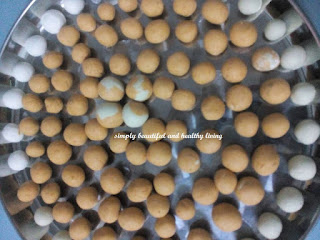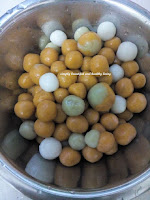First of all, HAPPY WINTER SOLSTICE/Dongzhi Festival (冬至节快乐) to all Chinese who are celebrating this meaningful festival. This year, Dongzhi Festival falls on 22nd December. Traditionally, Winter Solstice is also a time for the family to get together. During this festival, making and eating tang yuan 汤圆 (glutinous rice balls) symbolize reunion and its sweet syrup symbolizes prosperity. In China, Dongzhi was originally celebrated as an end-of-harvest festival.
According to Wikipedia, Dōngzhì Festival or Winter Solstice Festival (Chinese: 冬 至; pinyin: Dōngzhì; literally: "the extreme of Winter") is one of the most important festivals celebrated by the Chinese and other East Asians during the Dongzhi solar term (winter solstice) on or around December 22 (according to East Asia time). In 2015, the festival falls on Tuesday, December 22.The origins of this festival can be traced back to the yin and yang philosophy of balance and harmony in the cosmos. After this celebration, there will be days with longer daylight hours and therefore an increase in positive energy flowing in. The philosophical significance of this is symbolized by the I Ching hexagram fù (復, "Returning").
Traditionally, the Dongzhi Festival is also a time for the family to get together. One activity that occurs during these get-togethers (especially in the southern parts of China and in Chinese communities overseas) is the making and eating of tangyuan (湯圓) or balls of glutinous rice, which symbolize reunion. Tangyuan are made of glutinous rice flour and sometimes brightly coloured. Each family member receives at least one large tangyuan in addition to several small ones. The flour balls may be plain or stuffed. They are cooked in a sweet soup or savory broth with both the ball and the soup/broth served in one bowl. It is also often served with a mildly alcoholic unfiltered rice wine containing whole grains of glutinous rice (and often also Sweet Osmanthus flowers), called jiuniang.
In northern China, people typically eat dumplings on Dongzhi. It is said to have originated from Zhang Zhongjing in the Han Dynasty. On one cold winter day, he saw the poor suffering from chilblains on their ears. Feeling sympathetic, he ordered his apprentices to make dumplings with lamb and other ingredients, and distribute them among the poor to keep them warm, to keep their ears from getting chilblains. Since the dumplings were shaped like ears, Zhang named the dish "qùhán jiāoěr tāng" (祛寒嬌耳湯) or dumpling soup that expels the cold. From that time on, it has been a tradition to eat dumplings on the day of Dongzhi.
Old traditions also require people with the same surname or from the same clan to gather at their ancestral temples to worship on this day. There is always a grand reunion dinner following the sacrificial ceremony.
The festive food is also a reminder that celebrators are now a year older and should behave better in the coming year. Even today, many Chinese around the world, especially the elderly, still insist that one is "a year older" right after the Dongzhi celebration instead of waiting for the lunar new year.
To Taiwanese people, the festival in winter also plays a very important role. It is also a tradition for Taiwanese to eat tangyuan on this day. They also use the festive food as an offering dish to worship the ancestors.
In an interesting twist, in accordance with ancient Taiwanese history, many people take some of the tangyuan that have been used as offerings and stick them on the back of the door or on windows and tables and chairs. These "empowered" tangyuan supposedly serve as protective talismans to keep evil spirits from coming close to children.
In addition to following some of the customs practiced in China, the people of Taiwan have their own unique custom of offering nine-layer cakes as a ceremonial sacrifice to worship their ancestors. These cakes are made using glutinous rice flour in the shape of a chicken, duck, tortoise, pig, cow, or sheep, and then steamed in different layers of a pot. These animals all signify auspiciousness in Chinese tradition.
Another interesting custom in Taiwan is that many people take invigorating tonic foods during this particular winter festival. To the Taiwanese, winter is a time when most physical activities should be limited and you should eat well to nourish your body. This practice follows the habits shown by many animals which follow the law of nature and hibernate throughout winter months to rejuvenate and to preserve life. In order to fight cold temperatures, it is necessary to eat more fatty and meaty foods during winter when your body can better absorb the rich and nutritional foods at this time due to a slower metabolic rate.
Since Dongzhi is the "Extreme of Winter", Taiwanese regard it as the best time of the year to take tonic foods. Some of the most widely popular winter tonic foods enjoyed by Taiwanese to fight cold and strengthen the body's resistance are mutton hot pot and ginger duck hot pot. Other foods like chicken, pork, and abalone are also common materials used in making tonic foods with nurturing herbs such as ginseng, deer horn, and the fungus cordyceps.
This year, I decided to make a different syrup. Instead of the usual pandan and ginger syrup, I added lemongrass and osmanthus 桂花 as well. Well, it tasted much much better and is also healthier, right? As for the tang yuan, besides sweet potato, I also have green tea powder for the green color instead of the usual pandan colour too! Hehehe...
Ingredients :Sweet Potatoes Tang Yuan :
- 100g glutinous rice flour
- 150g orange sweet potato (steamed and mashed)
- 1tbsp cornstach
- 1/4 cup warm water
Method :
1) Mix the above ingredients and knead until a smooth dough is formed.
2) Divide the dough into several pieces and roll into small balls. I have various sizes!
3) Cook the glutinous rice balls in a pot of boiling water. Stir gently to prevent the rice balls to stick at the bottom. Please take note that when the rice balls float to surface, it is cooked.
4) Transfer the cooked tang yuan to a pot of cold water and drain.
5) Serve tang yuan in a bowl with your favorite syrup or sweet soup.
- 10 pandan leaves
- 10 lemongrass/serai (slit and crushed)
- 2 big thumbsized ginger (crushed)
- 2 bar of brown cane sugar
- some dried osmanthus
Method :
1) Put everything in a large pot and boil. I slow boiled for around half an hour as I love the fragrant of the ginger and lemongrass in the syrup. Mine is more towards like sweet soup dessert (tongsui) instead of syrup. You can adjust according to your preference.
Sorry to inform that for the time being, I have disabled comment box as I won't be able to return visit to my fellow bloggers who are kind enough to drop me a line or two. The comment box will be enabled when I am not so tied up with my work schedule. However, you may contact me by leaving your message or comment at SIMPLY BEAUTIFUL AND HEALTHY LIVING FACEBOOK. My sincere apologies for any inconvenience caused. Thanks for visiting my blog and have a nice day :)
2) Divide the dough into several pieces and roll into small balls. I have various sizes!
3) Cook the glutinous rice balls in a pot of boiling water. Stir gently to prevent the rice balls to stick at the bottom. Please take note that when the rice balls float to surface, it is cooked.
4) Transfer the cooked tang yuan to a pot of cold water and drain.
5) Serve tang yuan in a bowl with your favorite syrup or sweet soup.
Step by step pictures of cooking the tang yuan
Sweet Soup/Syrup : to taste (no exact measurement)
- 2.5litre water- 10 pandan leaves
- 10 lemongrass/serai (slit and crushed)
- 2 big thumbsized ginger (crushed)
- 2 bar of brown cane sugar
- some dried osmanthus
Method :
1) Put everything in a large pot and boil. I slow boiled for around half an hour as I love the fragrant of the ginger and lemongrass in the syrup. Mine is more towards like sweet soup dessert (tongsui) instead of syrup. You can adjust according to your preference.
Making tang yuan is very easy as you can 'mix and match' the ingredients to your liking
As for the sweet soup or syrup, you too can 'mix and match'' whatever that fancies you
Isn't it simply easy yet mouth-watering??
Happy Winter Solstice 冬至节快乐 to all my dear readers
To receive new updates, do LIKE SIMPLY BEAUTIFUL AND HEALTHY LIVING FACEBOOK.
Sorry to inform that for the time being, I have disabled comment box as I won't be able to return visit to my fellow bloggers who are kind enough to drop me a line or two. The comment box will be enabled when I am not so tied up with my work schedule. However, you may contact me by leaving your message or comment at SIMPLY BEAUTIFUL AND HEALTHY LIVING FACEBOOK. My sincere apologies for any inconvenience caused. Thanks for visiting my blog and have a nice day :)















0 Response to "Happy Winter Solstice 冬至节快乐 and Tang Yuan 汤圆 (Chinese Glutinous Rice Balls) in Sweet Fragrant Osmanthus Lemongrass Pandan Sweet Soup"
Posting Komentar